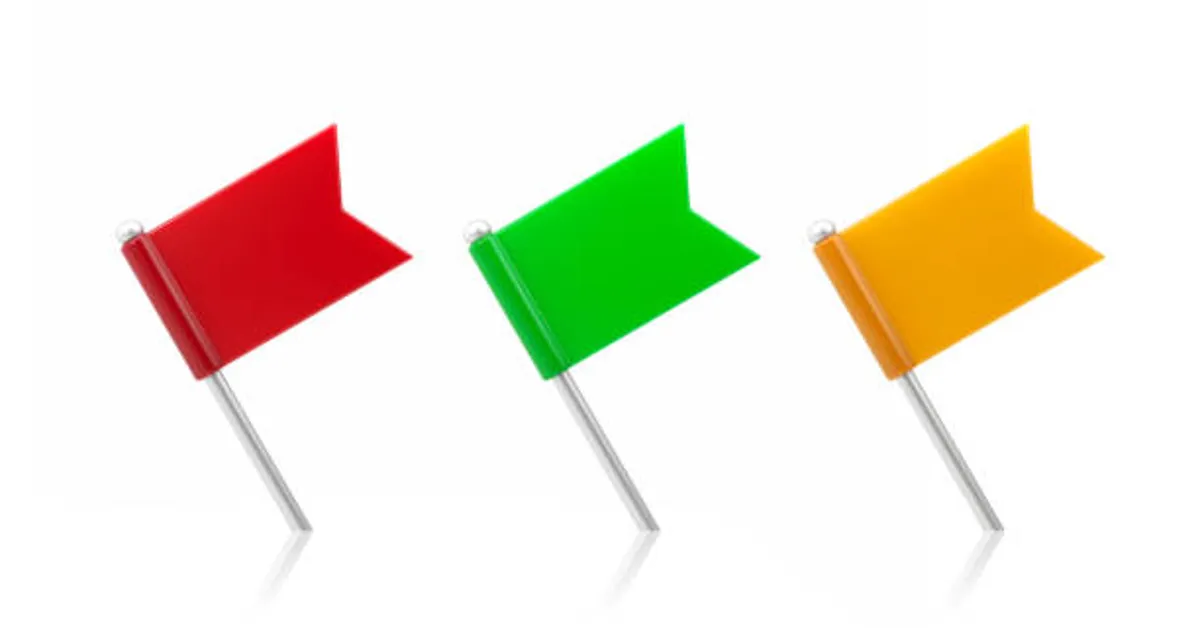In life, whether in relationships, friendships, workplaces, or other personal and social situations, people often use the terms red yellow green flag to describe different types of signals that help them assess the health, safety, or potential of an interaction or environment. These flags act as metaphorical markers—like traffic lights—to indicate whether we should stop, proceed with caution, or confidently move forward.
Understanding these flags is essential for emotional well-being, effective decision-making, and maintaining healthy connections. While red flags signal serious concerns, yellow flags represent situations that need closer observation, and green flags indicate safety, trust, and alignment with one’s values.
This article provides an in-depth explanation of what these flags mean, how to recognize them in various contexts, and how to respond appropriately.
1. The Concept of Red Yellow Green Flags
The flag analogy comes from multiple domains such as sports, driving, and maritime navigation, where different colors indicate distinct messages. In modern social and emotional contexts, these flags work as symbolic indicators of human behavior, relationship quality, or organizational health.
| Flag Color | General Meaning | Suggested Action |
|---|---|---|
| Red | Serious warning, danger, or harmful behavior | Stop or exit the situation immediately |
| Yellow | Potential concern, unclear intentions, or boundary-testing | Proceed with caution, monitor closely |
| Green | Positive signs, healthy interactions, mutual respect | Move forward confidently and nurture the relationship |
2. Understanding Red Flags
A red flag is a clear and often urgent sign that something is wrong. In relationships or environments, red flags indicate harmful, toxic, or unsafe behaviors that can negatively impact mental, emotional, or even physical well-being.
Common Red Flags in Different Contexts
- Relationships
- Controlling or manipulative behavior
- Disrespecting boundaries repeatedly
- Verbal, emotional, or physical abuse
- Dishonesty and frequent lying
- Friendships
- Exploiting your kindness without reciprocation
- Gossiping or betrayal of trust
- Competitive jealousy that undermines you
- Workplaces
- Unethical practices or corruption
- Discrimination or harassment
- Consistently unrealistic workload without support
Why Red Flags Matter
Ignoring red flags often leads to worsening problems. For example, tolerating dishonesty in a partner can escalate into deeper betrayals, while overlooking unsafe work practices can endanger your health.
How to Respond to Red Flags
- Trust your intuition and past experiences.
- Set clear boundaries and communicate concerns.
- Remove yourself from the situation if safety is compromised.
- Seek professional or legal support if needed.
3. Understanding Yellow Flags
A yellow flag signals potential caution. It does not necessarily mean danger, but it suggests you should slow down and observe the situation more closely.
Common Yellow Flags
- Relationships
- Difficulty expressing emotions
- Inconsistent communication patterns
- Overdependence on you for emotional needs
- Friendships
- Minor competitiveness that feels uncomfortable
- Occasional boundary-testing
- Avoidance of accountability
- Workplaces
- Unclear job expectations
- Lack of transparency in leadership
- Occasional unfair treatment
Why Yellow Flags Matter
Yellow flags are often early indicators of issues that can either resolve over time or develop into red flags if ignored.
How to Respond to Yellow Flags
- Have open conversations about your concerns.
- Watch for patterns rather than isolated incidents.
- Offer solutions and see if there is willingness to improve.
- Maintain healthy boundaries while assessing the situation.
4. Understanding Green Flags
A green flag is the sign of safety, respect, and alignment of values. It means that the environment, relationship, or connection is healthy and likely beneficial for your well-being.
Common Green Flags
- Relationships
- Consistent honesty and transparency
- Respect for your boundaries and individuality
- Shared goals and mutual support
- Friendships
- Celebrating your successes without jealousy
- Offering help without expectation of return
- Respecting confidentiality
- Workplaces
- Fair treatment and recognition of effort
- Clear communication and expectations
- Encouragement of growth and learning
Why Green Flags Matter
Recognizing green flags helps you invest time and energy into connections that nurture your growth and happiness.
How to Respond to Green Flags
- Appreciate and acknowledge the healthy behavior.
- Nurture and reciprocate positivity.
- Strengthen trust and continue open communication.
5. Psychological and Emotional Impact of Flags
The way we respond to red yellow green flags influences our mental and emotional stability.
| Flag Color | Emotional Impact if Ignored | Positive Impact if Addressed |
|---|---|---|
| Red | Stress, anxiety, emotional harm | Safety, self-respect, healthier choices |
| Yellow | Confusion, mixed feelings | Clarity, stronger boundaries, better understanding |
| Green | Missed opportunities for deeper connection | Increased trust, happiness, personal growth |
6. Practical Tips for Identifying Flags
- Listen to Your Intuition – Gut feelings often detect inconsistencies before the mind does.
- Observe Actions Over Words – Consistency matters more than promises.
- Seek Outside Perspective – Friends, mentors, or counselors can help identify flags you may overlook.
- Track Patterns – Isolated mistakes differ from repeated harmful behavior.
- Educate Yourself – Understanding healthy vs. unhealthy dynamics improves awareness.
7. Real-Life Examples
Let’s explore three scenarios that show how red yellow green flags might appear in the same situation.
| Scenario | Red Flag | Yellow Flag | Green Flag |
|---|---|---|---|
| Dating | Partner demands your phone password without consent | Partner takes a long time to open up emotionally | Partner supports your ambitions and respects boundaries |
| Friendship | Friend spreads false rumors about you | Friend cancels plans often but apologizes | Friend defends you when you are not present |
| Workplace | Supervisor harasses employees | Supervisor avoids giving feedback | Supervisor encourages professional growth and offers guidance |
8. Responding to Flags in a Healthy Way
- With Red Flags: Prioritize your safety. Use direct communication when possible, but remove yourself if danger is present.
- With Yellow Flags: Use curiosity and patience. Clarify misunderstandings but be prepared to escalate your caution if issues persist.
- With Green Flags: Actively contribute to the positive environment. Maintain mutual respect and gratitude.
Conclusion: Red Yellow Green Flag
Red yellow green flags are more than just metaphors—they are tools for navigating the complexities of human interaction and decision-making. By learning to identify and respond to them, you can protect your emotional health, build stronger relationships, and choose environments that align with your values.
Remember: ignoring a red flag can be costly, overlooking a yellow flag can lead to regret, and missing a green flag can mean passing up something truly valuable. Awareness and action are the keys to making these signals work for you, not against you.
ALSO READ: Comprehensive AMP Review: Features, Benefits, and Insights
FAQs
Q1: Can a yellow flag turn into a green flag?
Yes. If the concern is addressed openly and improvements are made, a yellow flag can become a green flag.
Q2: Are red flags always obvious?
Not always. Some red flags are subtle and become noticeable only over time.
Q3: Can green flags exist in unhealthy relationships?
Yes, but they may be overshadowed by red flags. Green signs do not cancel out harmful behavior.
Q4: How do I know if I am ignoring a red flag?
If you repeatedly justify harmful actions or feel unsafe but stay anyway, you may be ignoring red flags.
Q5: Are flags the same for everyone?
No. Cultural background, personal boundaries, and past experiences shape how individuals interpret flags.









